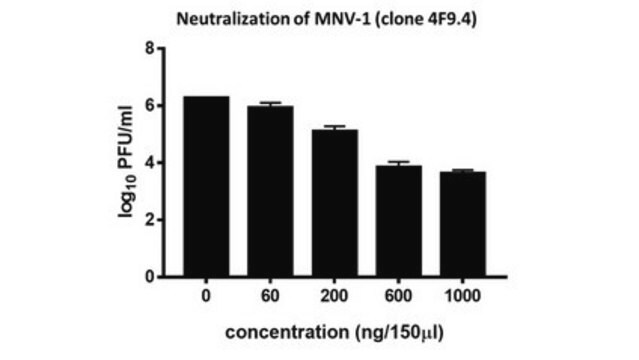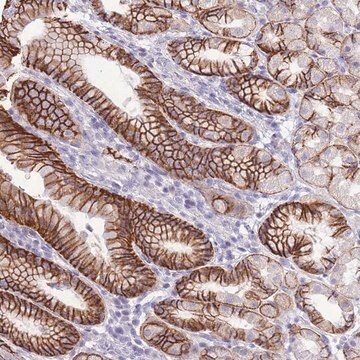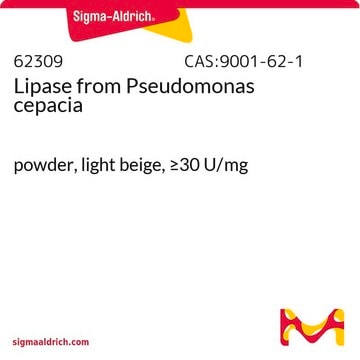おすすめの製品
由来生物
mouse
抗体製品の状態
purified immunoglobulin
抗体製品タイプ
primary antibodies
クローン
5C4.10, monoclonal
化学種の反応性
virus, norovirus
包装
antibody small pack of 25 μg
テクニック
ELISA: suitable
western blot: suitable
アイソタイプ
IgG2bκ
ターゲットの翻訳後修飾
unmodified
関連するカテゴリー
詳細
Norovirus is a member of the Caliciviridae family and is responsible for gastroenteritis outbreaks. Murine norovirus (MNV-1) that is about 28 to 35 nm in diameter, shares many biochemical and genetic features with human noroviruses. An analysis of the MNV-1 genome shows three open reading frames (ORF) that are characteristic of noroviruses and vesiviruses. ORF1 is reported to encode a predicted 187 kDa polyprotein that contains the 2C helicase, 3C protease, and 3D polymerase motifs. ORF2 encodes a 59 kDa capsid protein that can self-assemble into virus-like particles when expressed in a baculovirus expression system. ORF3 is reported to encode a putative 22 kDa basic protein. The norovirus capsid protein contains a highly conserved shell (S) and protruding (P) domain and the P domain is shown to contain binding sites for receptors and neutralizing antibodies. The S domain is shown to be highly conserved and the capsid sequence diversity is limited to the P domain. MNV-1 infection is reported to modulate the MAPK pathway to activate eIF4E phosphorylation and the activation of p38 and Mnk during MNV-1 infection is considered to be important for its replication. This monoclonal antibody, clone 5C4.10, recognizes the S domain portion of the viral capsid protein and is broadly reactive with pan-noroviruses of murine and human type. (Ref.: Kolawole AO, et al. (2017). mSphere 2: e00334-17; Kolawole, AO et al. (2014). J. Gen. Virol. 95(9); , 1958 1968; Royall, E., et al. (2015). J. Biol. Chem. 290(8); 4748-58; Wobus, CE et al. (2006). J. Virol. 80(11); 5104-5112).
特異性
Clone 5C4.10 specifically recognizes the S domain portion of capsid protein of murine Norovisrus.
免疫原
Infectious and UV-inactivated murine norovirus-1.
アプリケーション
Research Category
炎症及び免疫
炎症及び免疫
Anti-Norovirus (MNV-1), clone 5C4.10, Cat. No. MABF2097, is a mouse monoclonal antibody that detects murine Norovirus capsid protein and has been tested for use in ELISA and Western Blotting.
Western Blotting Analysis: A representative lot detected Norovirus (MNV-1) in Western Blotting applications (Kolawole, A.O., et. al. (2014). J Gen Virol. 95(Pt 9):1958-68).
ELISA Analysis: A representative lot detected Norovirus (MNV-1) in ELISA applications (Kolawole, A.O., et. al. (2014). J Gen Virol. 95(Pt 9):1958-68; Kolawole, A.O., et. al. (2017). mSphere. 2(5). pii: e00334-17).
ELISA Analysis: A representative lot detected Norovirus (MNV-1) in ELISA applications (Kolawole, A.O., et. al. (2014). J Gen Virol. 95(Pt 9):1958-68; Kolawole, A.O., et. al. (2017). mSphere. 2(5). pii: e00334-17).
品質
Evaluated by Western Blotting in RAW 264.7 cells infected with Murine norovirus-1.CW3.
Western Blotting Analysis: 1 µg/mL of this antibody detected Norovirus (MNV-1) in RAW 264.7 cells infected with Murine norovirus-1.CW3.
Western Blotting Analysis: 1 µg/mL of this antibody detected Norovirus (MNV-1) in RAW 264.7 cells infected with Murine norovirus-1.CW3.
ターゲットの説明
~57 kDa observed. Uncharacterized bands may be observed in some lysate(s).
物理的形状
Protein G purified
Format: Purified
Purified mouse monoclonal antibody IgG2b in buffer containing 0.1 M Tris-Glycine (pH 7.4), 150 mM NaCl with 0.05% sodium azide.
保管および安定性
Stable for 1 year at 2-8°C from date of receipt.
その他情報
Concentration: Please refer to lot specific datasheet.
免責事項
Unless otherwise stated in our catalog or other company documentation accompanying the product(s), our products are intended for research use only and are not to be used for any other purpose, which includes but is not limited to, unauthorized commercial uses, in vitro diagnostic uses, ex vivo or in vivo therapeutic uses or any type of consumption or application to humans or animals.
Not finding the right product?
Try our 製品選択ツール.
試験成績書(COA)
製品のロット番号・バッチ番号を入力して、試験成績書(COA) を検索できます。ロット番号・バッチ番号は、製品ラベルに「Lot」または「Batch」に続いて記載されています。
Jake T Mills et al.
Journal of virology, 97(12), e0171923-e0171923 (2023-11-30)
All viruses initiate infection by utilizing receptors to attach to target host cells. These virus-receptor interactions can therefore dictate viral replication and pathogenesis. Understanding the nature of virus-receptor interactions could also be important for the development of novel therapies. Noroviruses
Yifan Zhu et al.
Molecules (Basel, Switzerland), 25(18) (2020-09-11)
In this study, we investigated the impact of GD1a-expressing bacterial strains on the infectivity of murine norovirus (MNV). Eligible bacterial strains were screened from a sewage sample using flow cytometry, and their genetic sequences of 16S rRNA were determined. The
Yohei Takeda et al.
Viruses, 12(7) (2020-07-02)
Novel severe acute respiratory syndrome coronavirus 2 (SARS-CoV-2), influenza A virus (IAV), and norovirus (NV) are highly contagious pathogens that threaten human health. Here we focused on the antiviral potential of the medicinal herb, Saxifraga spinulosa (SS). Water-soluble extracts of
Lingling Liu et al.
Foods (Basel, Switzerland), 9(3) (2020-03-14)
As the leading cause of acute gastroenteritis worldwide, human noroviruses (HuNoVs) have caused around 685 million cases of infection and nearly $60 billion in losses every year. Despite their highly contagious nature, an effective vaccine for HuNoVs has yet to
Alberto A Amarilla et al.
Nature communications, 12(1), 3431-3431 (2021-06-10)
The current COVID-19 pandemic is caused by the severe acute respiratory syndrome coronavirus 2 (SARS-CoV-2). We demonstrate that despite the large size of the viral RNA genome (~30 kb), infectious full-length cDNA is readily assembled in vitro by a circular polymerase
ライフサイエンス、有機合成、材料科学、クロマトグラフィー、分析など、あらゆる分野の研究に経験のあるメンバーがおります。.
製品に関するお問い合わせはこちら(テクニカルサービス)








